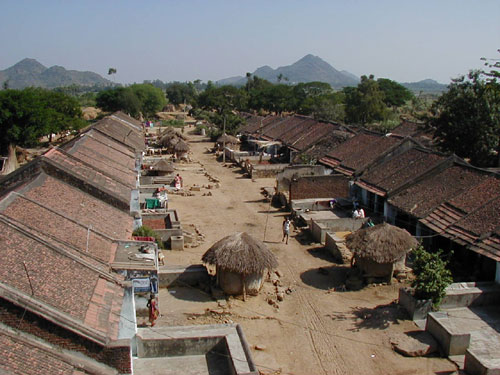The Saansad Adarsh Gram Yojana was launched last week, for the development of model villages. Under the Yojana, Members of Parliament (MPs) will be responsible for developing the socio-economic and physical infrastructure of three villages each by 2019, and a total of eight villages each by 2024.
The first Adarsh Gram must be developed by 2016, and two more by 2019. From 2019 to 2024, five more Adarsh Grams must be developed by each MP, one each year. This implies that a total of 6,433 Adarsh Grams, of the 2,65,000 gram panchayats, will be created by 2024.

A village in Andhra Pradesh (from India Together files)
Objectives
The key objectives of the Yojana include:
- The development of model villages, called Adarsh Grams, through the implementation of existing schemes, and certain new initiatives to be designed for the local context, which may vary from village to village.
- Creating models of local development which can be replicated in other villages.
Identification of villages
Members of Parliament (MPs) can select any gram panchayat, other than their own village or that of their spouse, to be developed as an Adarsh Gram. The village must have a population of 3000-5000 people if it is located in the plains, or 1000-3000 people if located in hilly areas.
Lok Sabha MPs can choose a village from their constituency, and Rajya Sabha MPs from the state from which they are elected. Nominated members can choose a village from any district of the country. MPs which represent urban constituencies can identify a village from a neighbouring rural constituency.
Funding
No new funds have been allocated for the Yojana. Resources may be raised through:
- Funds from existing schemes, such as the Indira Awas Yojana, Pradhan Mantri Gram Sadak Yojana, Mahatma Gandhi National Rural Employment Guarantee Scheme, and Backward Regions Grant Fund, etc.,
- The Member of Parliament Local Area Development Scheme (MPLADS),
- The gram panchayat’s own revenue,
- Central and State Finance Commission Grants, and
- Corporate Social Responsibility funds.
Implementation
A Village Development Plan must be created for each Adarsh Gram. While each village will develop a list of activities to be carried out, based on its own resources and requirements, possible activities have been listed in the guidelines for the scheme.
For example, Adarsh Grams can work towards providing universal access to basic healthcare facilities, promoting diversified livelihoods through agriculture related livelihoods and skill development, providing pension for all eligible families, housing for all, and promoting social forestry.
The table below outlines key functionaries at the national, state, district, and village level and their responsibilities.
Roles and responsibilities of key functionaries
|
Level |
Functionary |
Key roles and responsibilities |
|
National |
Member of Parliament |
|
|
Two committees, headed by the Minister of Rural Development, and Secretary, Rural Development, respectively.* |
|
|
|
State |
A committee headed by the Chief Secretary |
|
|
District |
District Collector |
|
|
Village |
Gram Panchayat and functionaries of schemes (at various levels) |
|
Note: *These committees will include members from other Ministries.
Monitoring
A web based monitoring system will be established to enable the MP and other stakeholders to monitor the scheme. Outputs relating to physical and financial targets will be measured each quarter. A mid-term evaluation and post-project evaluation will be conducted through an independent agency.
More information on the scheme is available in the guidelines for the scheme, here.























